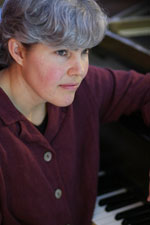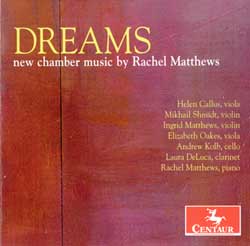
Rachel Matthews
.pianist .composer. teacher
Dreams
new chamber music by Rachel Matthews

Available from Centaur Records (CRC 3171), from ArkivMusic (Album ID 731957), itunes (MP3), or wherever CDs are sold.
Composer and pianist Rachel Matthews
Rachel Matthews is the winner of the 2010 International Music Prize for Excellence in Composition, the 2010 Maurice Gardner Composition Competition, and numerous grants and commissions. Her works have been heard in live performance and on radio broadcasts throughout the United States. As soloist and chamber musician, she has appeared at venues including the Curtis Institute in Philadelphia, the Corcoran Gallery in Washington, DC, and on the Accueil Musical series in Paris, and at festivals including Banff, Taos, and others. Rachel Matthews is a graduate of the Oberlin Conservatory and the North Carolina School of the Arts, and holds a doctorate in piano performance from the Peabody Conservatory. Her works are published by Ourtext and Comus Editions. Read Rachel's full biography.
To learn about the other artists who perform on this CD, expand "Meet the Artists".
| Dreams, for viola and piano | (11:06) | |
|---|---|---|
| 1. | Lusingando | 4:33 |
| 2. | Agitato | 1:51 |
| 3. | Mesto | 4:42 |
Hellen Callus, viola; Rachel Matthews, piano
| Piano Quintet | (23:31) | |
|---|---|---|
| 4. | I | 6:18 |
| 5. | II | 4:22 |
| 6. | III | 6:13 |
| 7. | IV | 6:27 |
Mikhail Shmidt, violin; Ingrid Matthews, violin;
Elizabeth Oakes, violin; Andrew Kolb, Cello;
Rachel Matthews, piano
| Partita, for unaccompanied violin | (20:21) | |
|---|---|---|
| 8. | Fantasia | 3:50 |
| 9. | Air | 2:45 |
| 10. | Bourrée | 1:58 |
| 11. | Minuet | 3:12 |
| 12. | Sarabande | 3:15 |
| 13. | Gigue | 5:21 |
Ingrid Matthews, violin
| Voices of Trees, for clarinet and piano |
(13:08) | |
|---|---|---|
| 14. | Listen through the rustling leaves | 5:46 |
| 15. | Night scherzo | 2:20 |
| 16. | Witness | 5:02 |
Laura DeLuca, clarinet; Rachel Matthews, piano
about Dreams...
- "Exquisite... one of those miracles in which a new musical vision is defined..."
- - Laurence Vittes, Strings 27.4 (Nov 2012): 78
(full text available by subscription only) - www.allthingsstrings.com
- - online review by Heather K. Scott, (Nov 2011)
about Rachel Matthews' performances...
- "compelling mastery and artistry"
- - Seattle Times
- "Rachel Matthews led thrilling chamber music performances"
- - Seattle Weekly
- "[B]rilliant. Matthews enriched every phrase she played with a sure sense of.… style and technical finesse"
- - Winston-Salem Journal
Expand "Contents" to listen to some excerpts from Dreams. In order to listen to the excerpts from Rachel's compositions, you need to either have a browser that supports HTML5 audio or have Flash installed. If you do not have either, you will receive a warning that "Flash version 9 or greater" is required. This normally happens only if you are using an older version of the Internet Explorer browser or ancient versions of other browsers. If the audio does not play for you, please contact the webmaster (via the link on the bottom right of this page).
Contemporary Chamber Music by Rachel Matthews


